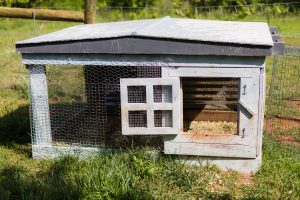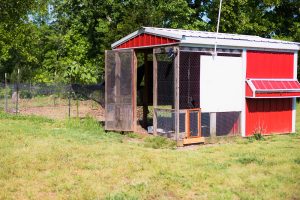Raising fluffy baby chicks is fun, until they suddenly have outgrown their first home! Here are the three types of homes your chicks will need as they grow.
Brooder Box
Babies (Day 1- ~7 Weeks)

When you bring home your baby chicks, the first thing you will need is a brooder box. It doesn’t have to be fancy, but it does need to be functional. One of the most dangerous parts of the brooder setup is the heat source. Whether heat lamp (buy the red bulb), or heat hover plate, always double check for fire hazards. Check on your chicks a few times a day to make sure they have clean water, food, and that the temperature is right. (95° F for the first week, dropping 5° F each week after that.)
Chicks need pine shavings for bedding, and ample space to get away from the heat if they feel too hot.
A large Tupperware box, stock tank, or pretty much anything that isn’t flammable, makes a good brooder. Do not use cardboard boxes!
Our little brooder is made from an empty, square water tank. We sawed off the top and left the metal cage around the plastic box. It is sturdy, easy to clean, and has worked perfectly for years and years. The best place to have your brooder set-up is in a garage or garden shed, somewhere with power and shelter from the elements. It is not advised to keep your brooder in the house. Baby chicks can quickly make a mess!
Grow-Out Pen
Teenagers (~7 Weeks- 4 Months)

A “grow-out” pen can be anything that keeps your fully feathered, yet still little, birds safe. After about 6-8 weeks in the brooder, your chicks should be almost ready for a bigger space outdoors. Bigger chickens are not kind to anything smaller than them. Adding chicks too soon, could be a death sentence for them, so it is best for your “teens” to have a little place of their own.
If the weather is chilly, please wait until they have become fully covered in feathers. If your climate is moderate and it doesn’t get too cold at night, a little head fluff is okay. If your littles start trying to fly out of the brooder to roost, its a good indication it is time to move!
Your grow-out pen needs to have small wiring. It does not have to be a huge space, but giving it a double layer of chicken wire, or better yet, rabbit wire, will keep predators away at night. The design could be anything you like! We have used our chicken tractor as a grow-out pen MANY times. We also used to keep teenager chicks in what is our current goat house.
You’ll find many uses for the grow-out pen when it isn’t being used!-and may find yourself bringing home more farm animals! (sorry husband!)
During the day, I like to open the door and let the teens out to forage. They will see it as their home, and will put themselves up at sunset, leaving you with the only task of locking them up.
Big Coop
Big Chickens (4 Months- Forever!)

Once your chicks are almost the same size as your grown birds, you can add them to your permanent coop. There will certainly be some pecking and fighting at first. They will establish a “pecking order,” but as long as no blood is drawn, it is safe to let them fight it out. I recommend leaving the whole flock up with the newbies for a few days. As long as your coop is big enough for them to get away from each other if needed.
A coop really benefits from having an attached fence. This allows the birds to get out, stretch and scratch if you decide to keep them up all day. A cheap, plastic garden netting over the top will keep out predators.
Your permanent coop will need the following:
Adequate space for the number of chickens you want.
Nesting boxes (1 per 4 hens)
Roosting branches
Shaded outdoor space
Sunny outdoor space
Enclosed section for nighttime sleeping (shavings for the floor)
Good Ventilation
Some pluses to consider adding!
Access to nesting boxes from outside
Automatic door
Window for ventilation
Rain catch for water
I hope you enjoyed these tips for being prepared with the right types of housing for your growing flock!